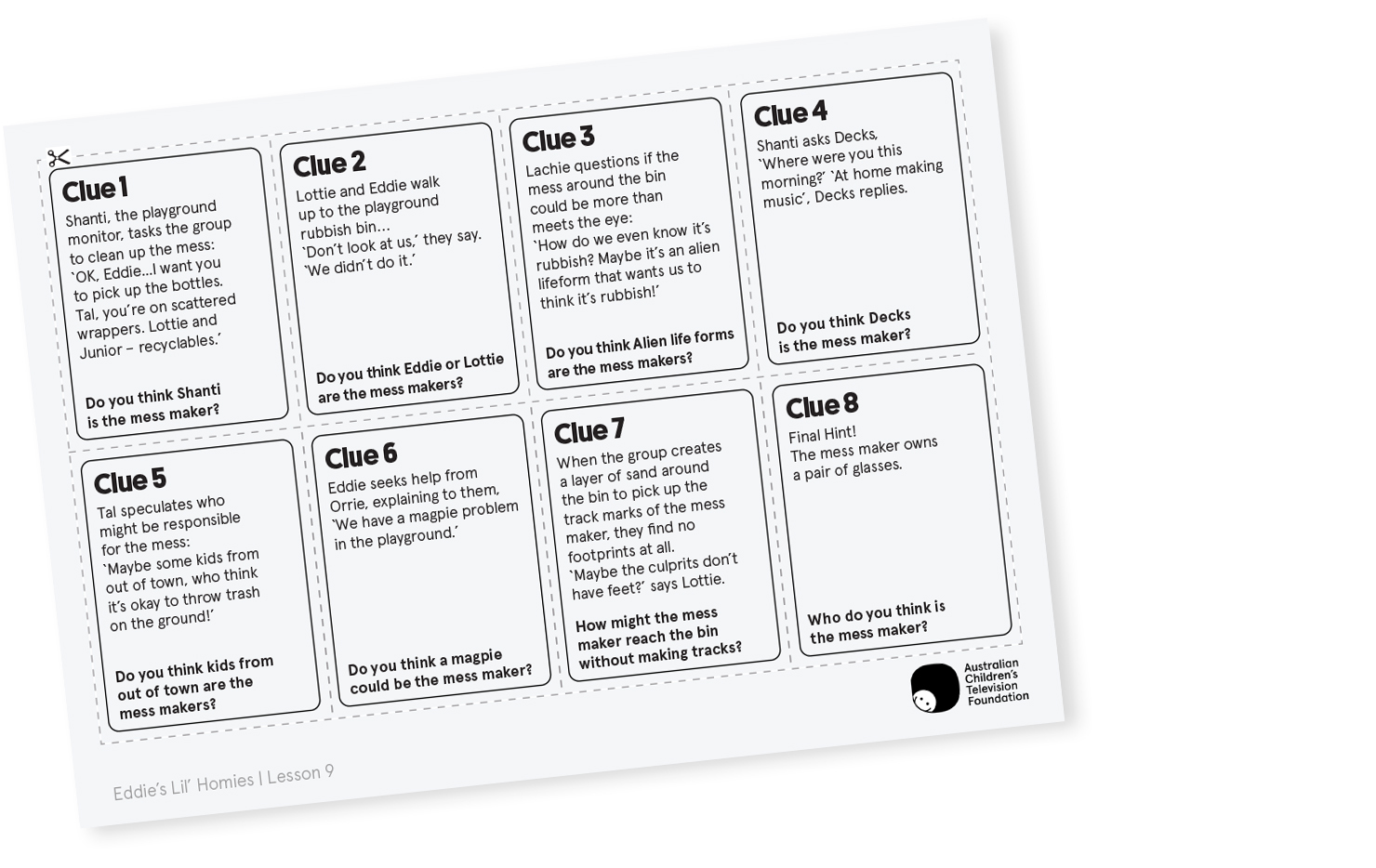In this lesson, we are learning to:
- Interpret verbal and non-verbal forms of communication.
- Analyse clues to solve a mystery with peers.
- Perform a scenario in pairs to practice group decision making skills.
We acknowledge and respect the Traditional Owners of lands across Australia, their Elders, Ancestors, cultures and heritage, and recognise the continuing sovereignties of all Aboriginal and Torres Strait Islander Nations.
We respectfully acknowledge the Wurundjeri People of the Kulin Nation, who are the Traditional Owners of the land on which the ACTF is based and pay our respect to their Elders past and present.
We are honoured to have the opportunity to learn from the oldest cultural storytellers in the world and seek to support Aboriginal and Torres Strait Islander practitioners to share their rich culture and perspectives with children in Australia and around the world via stories on screen.
Aboriginal and Torres Strait Islander people should be aware that this website may contain images, voices or names of deceased persons in photographs, film, audio recordings or text.
In this lesson, we are learning to:
Episode: ‘Messy Mystery' - Something or someone is making a mess in the playground, and Shanti won’t rest until she works out who – or what – is responsible! Meanwhile, Junior’s quest to become a Big Kid comes under threat when the culprit decides to reveal itself.
Find ‘Messy Mystery’ on NITV, Netflix or SBS On Demand.

Begin this lesson by engaging the class in a game of ‘Messy Mystery’.
In preparation, print the PDF resources:


Set the scene by announcing to the students that they are involved in trying to solve a big mystery. In the world of Eddie’s Lil’ Homies someone or something has been making a huge mess of the playground.
Organise students into small groups of ‘Messy Mystery Detectives’, reminding the groups that they will need to make decisions as a team. At the end of the activity, they will need to reach a group decision: who is the mess maker? Provide each group with a printout or device with a digital copy of the character sheets to support the discussion.
Ask the class for two volunteers: a hider and a seeker. Ask the seeker to step outside the classroom (or ask them to look away), then the hider places one of the clue cards somewhere in the classroom. Everyone, except for the seeker will need to know where the clue card is located. The seeker must find the clue card by interpreting the ‘hotter’ or ‘colder’ hints. Experiment with non-verbal cues: students clap slowly (cold) or quickly (hot) to communicate how close the seeker is to the card.
Once the seeker has found the clue card, it's time to celebrate! The seeker gives the card to the teacher to read aloud to the class. Then, groups can discuss. The information in the clues should help students to make decisions and narrow in on the culprit. Prompt students to explain and justify their predictions.
Repeat the process, selecting new volunteers to be the clue hider and the clue seeker until all the clue cards have been found.
In a class discussion, have students share their predictions about the culprit. Next, ask them to reflect on the ‘Messy Mystery’ detective game:
Explain to students that this game involved using a combination of non-verbal and verbal ways to communicate with others. Non-verbal communication is how we share information with others without using words or speech. When we all understood that slow, soft claps meant the clue was far away, we were communicating in a non-verbal way.
Students also spoke to share their ideas about the clues: this is verbal communication. Both verbal and non-verbal communication are important skills that we all need to learn and practise. Making a decision is challenging, but when we work with others, we can use lots of different ways to understand.
In the Eddies Lil’ Homies episode titled ‘Messy Mystery’, Shanti and the group worked together to figure out how the mess was appearing from the bin. Using communication, the group analysed clues, tried different approaches and eliminated suspects.
Watch ‘Messy Mystery’ to reveal who was responsible for making the mess in the playground.
As a class, revisit the idea of group decision-making, this time following the story of the little magpie chick found by Junior at the base of the playground gum tree. Have students identify and share how the characters reached a decision about helping the magpie chick?
The group exchanged ideas, asked questions, and shared their knowledge about wild animal care. The information shared was important to help them collectively make decisions, to do the best thing for the magpie chick and the magpie mother.
Rewatch this short clip from ‘Messy Mystery’: 09:51-10:28.
Draw from the dialogue to support a class discussion about how groups make good decisions together.
To foster communication strategies for group decision-making and enable students to demonstrate their understanding, ask students to role-play a situation where a group decision must be made. Suggest a range of situations that relate to the students’ world, and resources such as toys, puppets or images to stimulate their imagination.
Remind students to be safe, respectful, and kind. Everyone in the group should have the opportunity to share their thoughts, feelings, knowledge and opinions.
Examples situations could include:
|
|
Foundation |
Years 1 and 2 |
Critical and Creative Thinking |
||
Inquiring |
Identify and explore relevant points in information provided on a topic. |
Identify and explore relevant information from a range of sources, including visual information and digital sources.Identify and explain similarities and differences in selected information. |
English |
||
Language |
AC9EFLA02Explore different ways of using language to express preferences, likes and dislikes.AC9EFLA07Explore the contribution of images and words to meaning in stories and informative texts. |
AC9E1LA02Explore language to provide reasons for likes, dislikes and preferences. |
Literature |
AC9EFLE01Share ideas about stories, poems and images in literature, reflecting on experiences that are similar or different to their own by engaging with texts by First Nations Australian, and wide-ranging Australian and world authors and illustrators.AC9EFLE02Respond to stories and share feelings and thoughts about their events and characters.AC9EFLE04Explore and replicate the rhythms and sound patterns of literary texts such as poems, rhymes and songs. |
AC9E1LE01Discuss how language and images are used to create characters, settings and events in literature by First Nations Australian, and wide-ranging Australian and world authors and illustrators.AC9E1LE02Discuss literary texts and share responses by making connections with students’ own experiences.AC9E1LE04Listen to and discuss poems, chants, rhymes and songs, and imitate and invent sound patterns including alliteration and rhyme.AC9E2LE04Identify, reproduce and experiment with rhythmic sound and word patterns in poems, chants, rhymes or songs. |
Literacy |
AC9EFLY02Interact in informal and structured situations by listening while others speak and using features of voice including volume levels.AC9EFLY05Use comprehension strategies such as visualising, predicting, connecting, summarising and questioning to understand and discuss texts listened to, viewed or read independently. |
AC9E1LY05Use comprehension strategies such as visualising, predicting, connecting, summarising and questioning when listening, viewing and reading to build literal and inferred meaning by drawing on vocabulary and growing knowledge of context and text structures.AC9E1LY02Use interaction skills including turn-taking, speaking clearly, using active listening behaviours and responding to the contributions of others, and contributing ideas and questions.AC9E2LY02Use interaction skills when engaging with topics, actively listening to others, receiving instructions and extending own ideas, speaking appropriately, expressing and responding to opinions, making statements, and giving instructions. |
Health and Physical Education |
||
Interacting with others |
AC9HPFP02Practice personal and social skills to interact respectfully with others. |
AC9HP2P02Identify and explore skills and strategies to develop respectful relationships. |
Personal and Social Capability |
||
Social managementCommunicate effectivelyWork collaborativelyMake decisionsNegotiate and resolve conflict |
Share experiences of cooperation in play and group activities.Identify options when making decisions to meet their needs and the needs of others.Listen to others’ ideas, and recognise that others may see things differently from them. |
Discuss the use of verbal and nonverbal communication
|
Social AwarenessAppreciate diverse perspectives |
Acknowledge that people hold many points of view. |
Describe similarities and differences
|